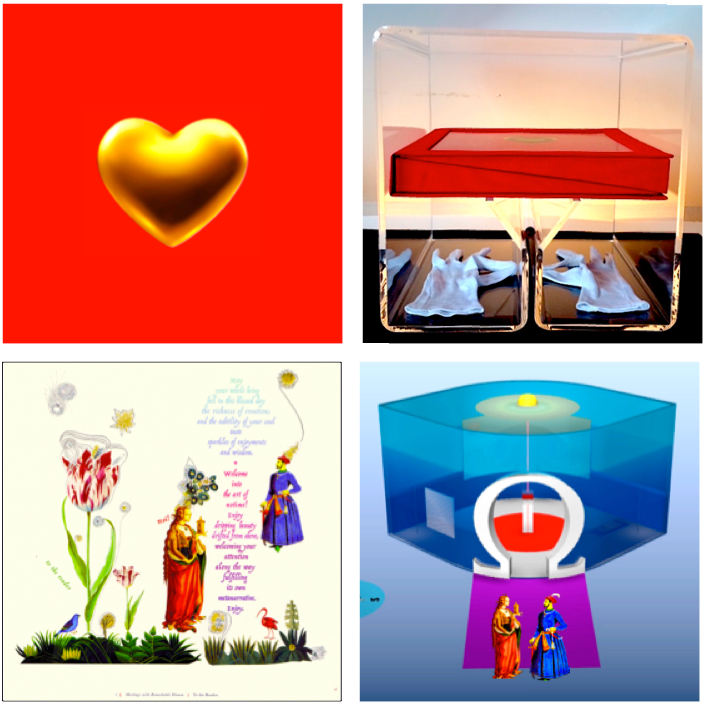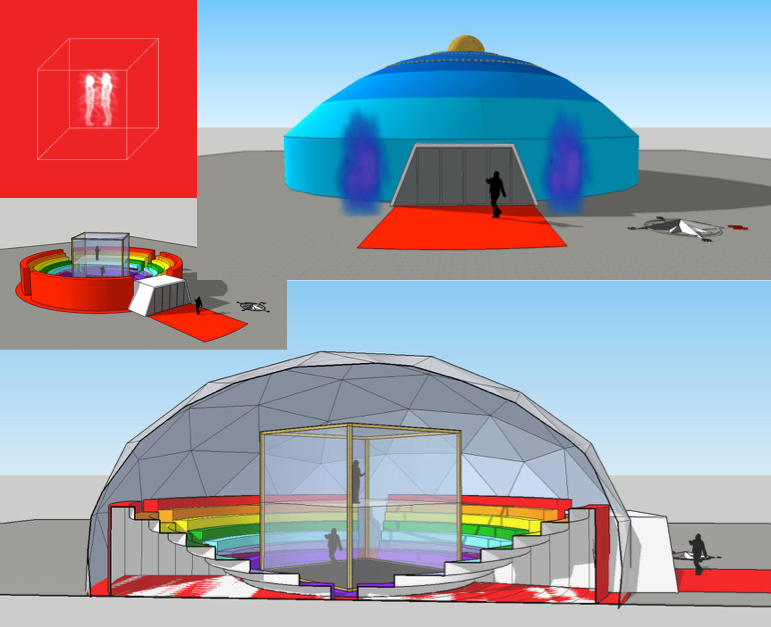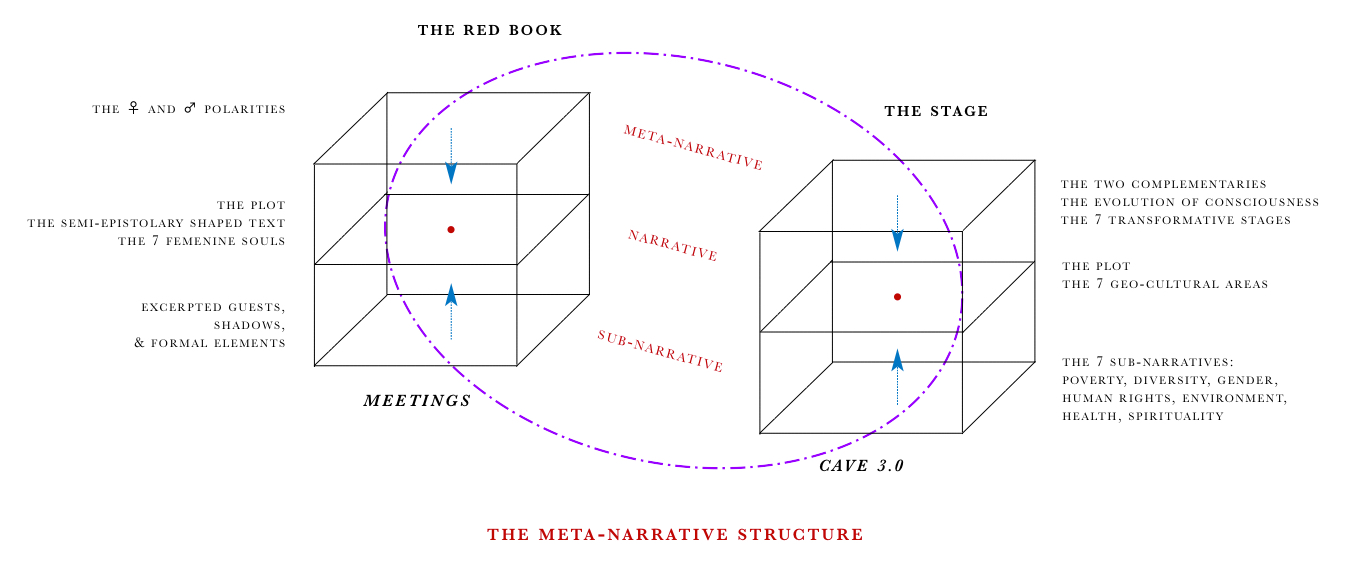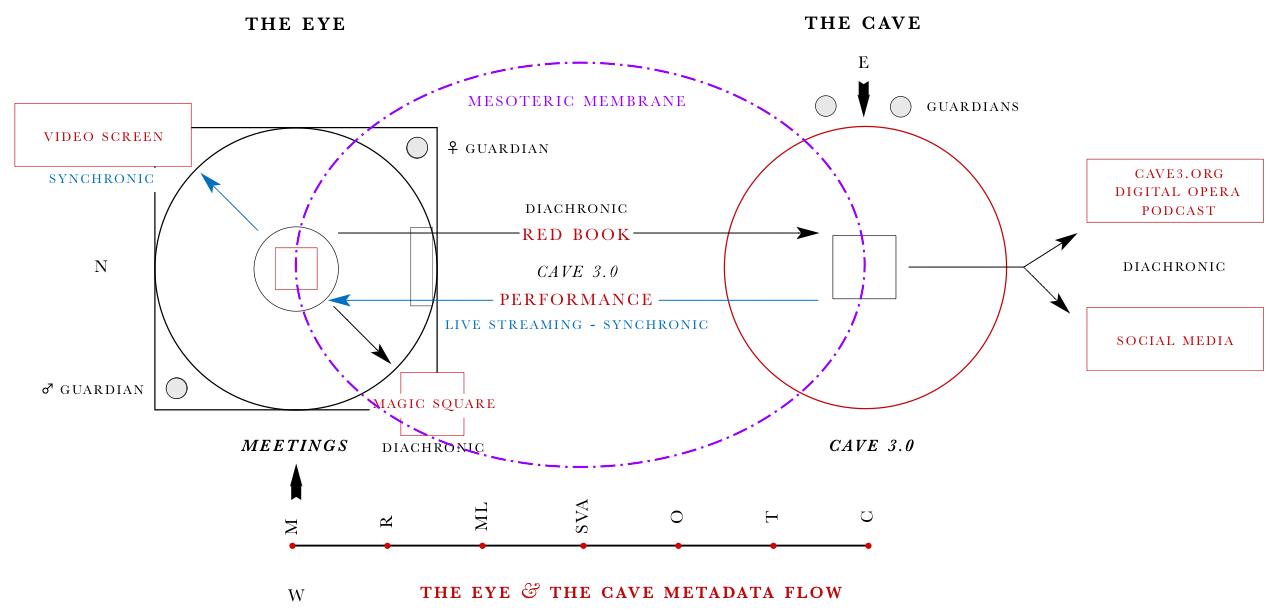The Polarities
The dark side of the Moon and the bright face of the Sun.
The sacred marriage of Heaven and Earth
The Cave is an image of the world, of the world’s centre. It is a symbol of the universe, of the heart, the principle of being, the meeting place of the divine and the human, where the King and the Queen enact the sacred marriage of heaven and earth. In the cave of the heart, the soul, the vital centre, the kernel of immortality, is symbolized by the world egg, the golden embryo, the inner sun.
A pilgrimage to the source
In pre-existing states of consciousness, the cave was perceived as a ‘subterranean’ world, a class of subconscious sepulchre from which the cosmos has to come out, a resurrection, followed by a journey in open air represented as navigation beyond the physical world, performed as a funerary rite of transition and rebirth. Death and second birth, third birth, lesser and greater mysteries, psychic and spiritual rebirth, birth in the cosmos. A pilgrimage to the source set off with the descent into Hell before attaining Paradise on Heaven. In other words, Hell is the daily human state of half-aware consciousness; with its subterranean perception unfit to grasp the full spectrum of reality.
Feminine and masculine itineraries
The cave of the heart — gupta, kruptos, crypt, cave, cryptic — is obscure, concealed, secret… until is enlightened. Its entrance might be hidden, or by a way of a labyrinth, secured by supernatural guardians, for entering the cave is re-entering Mother Earth’s womb, a place of burial and rebirth, the feminine principle, whose diagram, alike for the heart, is the downward triangle into the hidden esoteric realm. Transiting the cave is transmuting the journey, with a final exodus via its upper opening, the solar hub, the sun door in the centre of the dome, the eye of the cupola, the keystone, the crown of the head, the eye of the needle, the eye of the heart in spiritual perception, enlightenment, intuitive vision, wisdom. The eye is solar, masculine, the upward triangle, the mountain, the visible and external exoteric apex. Both the Eye and the Cave partake of the axial symbolism.
Symbols act by virtue of inverse analogy, as in the water the upside-down image is the reversed reflection of the upward image, so are the symbol and the symbolized, and likewise in inverse relationships, the Eye and Cave meta-spaces interact in the work. The Eye, traditionally and symbolically masculine, has at its centre, atop of a plinth, the Matrix, the exoskeleton of the Red Book with its downward triangle, the yoni, informing the whole meta-space with its feminine energy. At the other side of the spectrum, the Cave, traditionally and symbolically feminine, has at its centre the staged Matrix on which the itinerary of consciousness towards enlightenment of the opera Cave 3.0, ascends to the eye of the cupola, informing the Cave mate-space with its masculine upright stance.
The two principles are not different entities
The two principles are not ontologically different entities, rather two aspects of the same underlying wholeness, interrelated and mutually generative perspectives emerging with the development of human consciousness in its dynamic interchange with life and the cosmos.
The EYE meta-space — The livre d’artiste Meetings with Remarkable Women, the Red Book.
In the city centre, the lunar, feminine polarity, the Eye meta-space — here in the acceptation of the physical eye, the I, and the Third eye — is an energetic area determined by half-squaring a circle of the same width of one face of the staged Matrix in the Cave. The Centre is contraction, status quo, hooked to its own fixity, unable to move, deeply rooted in its granitic mould.
The meta-space itself has the shape of an eye, with inside, at each end of the palpebral commissures where corners converge, one of the two Guardians of the Threshold[1], the personification of the masculine and feminine polarities cast in clear acrylic glass silhouettes, gendered, in sitting posture, with gold and silver wire-crowned inlays, enlightened by a white spotlight, the feminine from above, the masculine from below, in antinomic fashion.
On the upper eyelid wall, a curved screen; on the facing lower eyelid wall, a flat 9 squares Magic Square[2] screen; the two screens act as the eyelids, opening up or shutting down to vision, meeting their sights in the centre.

In the centre of the Eye, on the iris[3], in the pupil[4], on a plinth, a single sheet of clear acrylic folded in 8 turns shapes up the Matrix, a cubic exoskeleton with front and back open faces, and a yoni[5] in the middle. At the intersection of the Y, a red pearl sits in an unstable stance; on the lower plane, flanking the pearl, a pair of white gloves in a mirrored mudrakhya mudra[6]; on the mesoteric plane, the first copy of Meetings with Remarkable Women, the Red Book, a transdisciplinary multilayerd livre d’artiste, integrating multiple systems of representations at the junction of scripture and visual meta-narrative in which the co-protagonists polarities interplay dialogically with a variety of formal elements. The plot unfolds the artist’s autobiographic one-sided epistolary journey across the 7 dimensions of the feminine soul gathered from encounters with real women. On the sub-narrative plane, the text interacts with shadows deprived of matter, imaginary insertions and excerpted guests advancing an illusory itinerary of self-knowledge, underlying a subtle content surfacing here and there in a non-linear fashion to distract unfocused attention. Digitally printed on demand with archival pigment in 77 copies sheltered in a square red cases, each wrapping 77 unbound pages illuminated by hand with polar silver and gold leaf.
Read more on the Meeting with Remarkable Women website.
The CAVE meta-space — The multidisciplinary opera Cave 3.0. A laic initiation.
In the urban periphery, at the margin, the ‘physical’ counterpart of the Eye, the solar, masculine polarity, the Cave/venue meta-space is itself the Cave: a self-contained multi-dimensional 360° theatrical geodesic dome within and around which the operatic performance takes place. The decentralised venue brings the opera house and the performance beyond the conventional stage right into the urban fringe, challenging the social and cultural ‘central’ paradigm. The margin is expansion, vitality, porous by nature, subject and object of a vibrant ever-changing diversity, constantly testing the extent of its own edge.
Standing outside the entrance door, two floating Guardians of the Threshold, hologram[7], images, of a finer substance than their acrylic homologous in the Eye — are welcoming and interacting with the opera goers. Indoor, the traditional Greek cavea is arranged in 7 stepped tiers of seats — levels of consciousness, geo-cultural areas, chakras, colours, musical notes, etc. — intersected by a four-rayed corridor heading to the four directions of space — the elementals, the seasons, and all other quaternary expressions.

At the centre, the three-layered staged Matrix embodies the esoteric, the mesoteric and the exoteric consciousness throughout the 1st, 2nd, 3rd and 4th tiers of the Earthly narrative. The meta-narrative is screened instead on the three-layered vault, the 5th, 6th and 7th dimensions of consciousness, where shadows and diaphanous images of the Heavenly abode interact in real time with the human condition unfolding underneath in the cavea.
Cave 3.0, the title borrows from Plato’s Allegory of the Cave, is a multidisciplinary opera in 2 acts, Prelude, 7 scenes, and Epilogue. The narrative unfolds the evolution of consciousness across 7 transformative stages towards enlightenment as perceived and narrated throughout 7 geo-cultural regions around the world, a journey equated to the itinerary of consciousness becoming self-aware. The libretto spans various planes of references, from traditional lore, myths and legends to iconographic, literary, symbolic and spiritual sources as they appear in their respective cultures, integrating discursive strategy and narrative paths with the music and the other semiotic fields. The orchestration is displayed by a Septet family of instruments: an overtone choir; the operatic voices; winds [bansuri Bn]; brass [Hn Sax]; strings [koto Vc]; percussion [Gng Vib]; and live electronics. Structural to the libretto, 12 Aria of Death & Rebirth signal the gradual transmutations of consciousness to enlightenment, out of the cave. The internal time of narration unwinds from void to fullness, perceived sequentially by the linear binary thought, yet nonlocal and co-existing, non-linear in the whole human make-up, and in a non-linear manner are performed in the work.
The stage-project combines music, live performers, video, singers and dancers alongside holographic imagery, drones, and live streaming as part of the operatic language. Holograms are ephemeral characters embodying the subtle side of reality, voiced by the overtone choir. Drones are entities manoeuvred by an external controller, deprived of free will, with a coarser resonance, self-determined yet aligned with dharma in its mundane implementation.

Cave 3.0 is part of the Spanda Foundation’s Musiké project for the conservation of the ethnomusicological heritage under the patronage of Arvo Pãrt, an endeavour aligned with the UNESCO program for the safeguard of the intangible cultural heritage (ICH).
Read more on the Cave 3.0 website.
The EYE & CAVE metadata flow
The Eye and the Cave are in a data-exchange mode, a two-way itinerary linking Centre and Periphery, Establishment and Margin, the Feminine and the Masculine dyad, igniting in their inter[dis]course the intervening nodal bodies.

In point of fact, from the Eye space at one end of the spectrum, selected textual data of the Red Book are integrated into the opera’s libretto being performed in the Cave at the other end side, while the whole performance is synchronically live-streamed back into the Eye upper eyelid screen, though diachronically in each of the 9 screens of the lower eyelid Magic Square by an algorithm performing a delayed 9-steps counterclockwise[8] loop-sequence to create an hyperbolic vortex in the narrative spacetime continuum and, as images and and fragmented clips, into the video devices in each nodal cultural institution’s premises and, as a podcast, beyond the physical field of the work, into the Digital Opera House receptor in the Cave3.org platform and into the social media network. When the Cave 3.0 performance is on hold because of programming, the recorded première is screened in a loop on both eyelids of the Eye and in the Nodal Partners premises. The premiere is saved on a memory-card and afterwards — diachronically — included in each of the Red Book as the original digital imprint of its legacy.
——————
[1] The Guardians of the Threshold, also denoted as the pillars of the Temple, or the right and left sides of the Tree of Life — as in the Gunungan beginning and closing every Wayang performance — or the Sephirot of compassion and justice, or the Black and White Lodges, the Hinduis and Buddhist Dvarapala at the gate of the Temple and so forth, stand for all polarities that, once integrated, allow crossing the threshold to access a new dimension of consciousness. According to traditional knowledge, the Guardians of the Threshold must be confronted at an early initiatory stage of the evolution of consciousness. Inside the Eye space, they bear a material emergence being cast in transparent acrylic glass; outside the Cave entrance, they are instead holograms characters, immaterial beings devoid of tangible consistency.
[2] A Magic square is a square divided into smaller squares each containing a number consisting of the distinct positive integers 1, 2, …, arranged in such a way that the figures in each vertical, horizontal, and diagonal row add up to the same value.
[3] In ancient Greek, the word iris means “eye of heaven”. In Greek mythology, the goddess Iris (Ἴρις) is the personification of the rainbow, believed to be her dress, and the messenger of the gods. Like the rainbow is a bridge to the sky, Iris took the orders of Zeus and the other deities from the “eye of heaven” and, sliding down the curve of the rainbow, she appeared in front of the people in a human form and revealed the orders to them. She travels with the speed of wind from one end of the world to the other, into the depths of the sea and in the underworld. According to a myth, Iris mated with Zephyr and created Eros, the winged god of love.
[4] Pupil, the centre of the eye, from Latin pupilla, originally “little girl-doll,” diminutive of pupa (girl; doll) so called from the tiny image one sees of oneself reflected in the eye of another person. Greek used the same word, kore (girl), to mean both “doll” and “pupil of the eye”. According to Plato, “self-knowledge can be obtained only by looking into the mind and virtue of the soul, which is the diviner part of a man, as we see our own image in another’s eye.” [‘Alcibiades’, I.133].
[5] In Hinduism, the yoni (Skt: lit. abode, source, womb, or vagina) is the female genitalia, a sacred space symbol of the goddess Shakti, the creative feminine power that moves through the entire universe. In Shaivism, the branch of Hinduism devoted to worship the god Shiva, the yoni is often associated with the lingam (Skt: lit. sign, symbol, or mark), the symbol of Shiva, the male creative energy, depicted as a phallus or phallic object representing the axis mundi, the cosmic pillar, emanating its all-producing energy to the four quarters of the universe, iconographically rendered as resting in the yoni as a cylinder in a spouted dish. The lingam and the yoni together represent the eternal process of creation and regeneration, the union of the male and female principles, and the totality of all existence.
[6] Mudra (Skt: lit. seal) is understood as an inscriptive form that follows the linguistic parameters, expressing symbolic meaning through systematically codified patterns. Mudras are hand gestures adopted during yoga postures (asana) and breath control (pranayama) and in some form of meditation direct the flow of energy into the subtle body. Beyond the level of linguistic symbolism, mudra is a kinetic energy, essentially the form of a movement whose meaning is embedded in the kinetic modalities of the hands. A mudra is an entity composed of a number of spatiotemporal properties such as tempo, duration, rhythm, motion trajectories of the hands and eye movements. Mudra is the ‘optical’ dispositive of the hand, it sees things, relates events, interprets their meanings and experiences in a range of emotions through movements. In a theatrical performance, the mudra connects the subjective and objective realities through the kinetic properties of the hands. The Mudrakhya mudra, performed with forefinger and the thumb joined and the others released, symbolizes the harmonious fulfilment of growth.
[7] Holograms are characters of the play. The holograms refer to the related holographic principle of string theories that conjectures a property of quantum gravity stating that the description of a volume of space can be thought of as encoded on a lower-dimensional light-like boundary, as the gravitational horizon. Here, they stand as self-governing entities of the subtle reality.
[8] The counterclockwise motion unwinds and resets to zero the historic time. A common feature of any kinetic ritual, as, for instance, the widdershins circumambulation of sites endowed with power, or the dervish and shamanic circular dances, or the bringing out the Sefer Torah from the ark, or other cosmogonic rituals attempting to unwind the linear time in order to access the sacred atemporal dimension are often depicted as circular, yet they might be more fittingly rendered as an upward multidimensional spiralling breath.